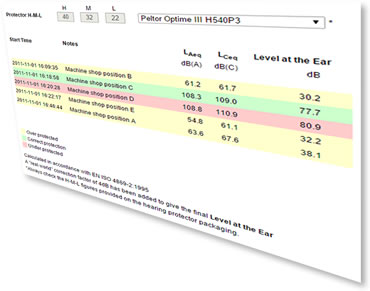Hearing Protector Assessment - Estimating the Sound Level at the Ear

When workers are exposed to high noise levels and hearing protection is needed, it is important to ensure that the protection provided is adequate. Various methods are available to check the level at the ear, but the process involves:
- Measure the noise levels that the worker is exposed to.
- Obtain the protection figures (usually on the side of the protector's box).
- Use the protection figures and the noise measurements to estimate the level at the ear.
- Produce reports and make recommendations.
Don't forget that it is also a mistake to over-protect the worker. This may result in the use of heavier protectors than necessary and ultimately to them not being worn regularly enough.
NoiseMeters Applications uses either the HML method or NRR method, depending on which regulations you are following:
- Under OSHA regulations we use the NRR method
- Under ISO regulations we use the HML method
NRR Hearing Protector Assessment

Typical NRR Hearing Protection Report
Coded for over protection (yellow) and under-protection (red)
The NRR method is used when you have NoiseMeters Applications set to OSHA, the most common of the regulations used in the USA. This method uses the "A" weighted sound level or Lavg (average sound level) measured by the sound level meter along with the NRR figure for the hearing protector to calculate the level at the ear. This figure is derated by 50% as recommended by OSHA.
The report can be produced for multiple measurements. The NRR figure can be entered manually or you can select the hearing protection you use from the list available.
HML Hearing Protector Assessment

Typical HML Hearing Protection Report
Green coding shows acceptable level at the ear
The HML method is used when you have NoiseMeters Applications set to ISO. This method uses the "A" and "C" weighted sound level or Leq along with the HML figures for the selected protector to calculate the level at the ear. As recommended by many regulations the level is derated by 4dB to allow for "real world" factors.
The report on the right shows multiple measurements (different positions in a machine shop) being used to assess the suitability of one hearing protector model.
Which Sound Level Meter?
While the NoiseMeters Applications supports a range of meters, not all have the ability to make the measurements required for hearing protection assessment. If you are measuring to the OSHA regulations then any of the meters supported here will be fine, as they all measure the "A" weighted sound level. If you are following ISO and using the HML method then the sound level meter needs to measure both "A" and "C" weighted sound level or Leq.
Suitable meters:
- OSHA NRR Method - CEL242, CEL246, CEL620A1, CEL620A2, CEL620B1, CEL620B2
- ISO HML Method - CEL620A1, CEL620A2, CEL620B1, CEL620B2
Need some help with this? Give us a call or drop us an email, we are very happy to help and ensure you get the right meter for the job.